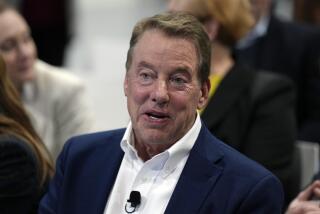Mark Fields to replace Alan Mulally as Ford chief executive
- Share via
Alan Mulally, an aerospace engineer who helped Ford Motor Co. avoid the bankruptcy filings and federal bailouts of its U.S. automotive siblings, said Thursday that he will step down as the company’s chief executive in July.
He will be succeeded by Mark Fields, a longtime Ford executive who two years ago was named chief operating officer and Mulally’s second in command. The move was approved by the company’s board of directors Wednesday.
FOR THE RECORD:
Ford CEO: An article in the May 2 Business section about Alan Mulally’s decision to step down as Ford Motor Co.’s chief executive stated that the company borrowed $23.5 million in 2006. The automaker borrowed $23.5 billion.
The change marked the smoothest transition at the top executive ranks yet for the company, which in previous generations had suffered through bitter rivalries involving top managers and members of the founding Ford family. Bill Ford, the automaker’s executive chairman and great-grandson of founder Henry Ford, praised Mulally for both his accomplishments and the grace of his exit.
“We know Alan is a hall-of-fame CEO, and we all know that most hall-of-fame CEOs cannot let go,” he said.
A former Boeing Co. who led the development team for the 777 jetliner, Mulally came to Ford nearly eight years ago as the rare outsider. He was neither an automotive executive nor a family member, but was offered the job by Bill Ford, who was stepping down and believed that the company needed a new direction.
“After Mr. Mulally took over, Bill Ford stepped back from day-to-day operations to allow Mulally to run the business — and eliminate the ‘court politics’ that had characterized Ford since the Henry Ford days,” wrote Barclays Capital analyst Brian Johnson in an investors report Thursday.
The company then borrowed $23.5 million — essentially mortgaging all of its assets in late 2006 — to have a cash war chest to survive the downturn in the economy that crippled General Motors Co. and Chrysler Group.
“We knew from Day One that we had to restructure the business to get back to profitability,” Mulally said.
Mulally, 68, and his team then implemented the so-called One Ford plan, which reduced expenses and created economies of scale through parts sharing and designing global vehicle platforms. He sold off several luxury brands, including Jaguar Land Rover, Volvo and Aston Martin. Mulally closed the Mercury brand and launched a remake of the struggling Lincoln nameplate. Ford also sold nearly all of its stake in Mazda.
When the recession ravaged the auto industry, Mulally became its spokesman, testifying before Congress that a government bailout of Ford’s U.S. rivals was good for both the economy and the industry.
“The American auto industry should pass the hat and build a statue of Alan,” said Mike Jackson, chief executive of AutoNation Inc. the nation’s largest auto dealer chain. “Having positioned Ford not to need a bailout gave hope for what could be. And his arguing that competitors GM and Chrysler should be saved for the good of the industry and America — wow, that’s exceptional leadership.”
Others agreed that his accomplishments won’t be soon forgotten.
“Mulally will be seen as the man who saved Ford. He came in after a series of failed leaders that had allowed Ford’s products and position to deteriorate to a precarious position,” said Karl Brauer, an analyst at auto information company Kelley Blue Book.
While Mulally quarterbacked Ford’s recovery, Fields played an important role as chief of its business in North America, the automaker’s biggest market, said Stephanie Brinley, an analyst at IHS Automotive.
Fields, 53, inherits a healthy company with strong products and profitability, Brinley said.
And because he is relatively young, he’s likely to run the company for at least a decade, providing stability in senior management, she said.
Over the last 25 years, the New Jersey native and Harvard business school graduate has gained vast experience in global markets, in turnarounds and restructurings. That suits him well for the challenges Ford faces, Brinley said.
Fields, however, is not an engineer. He said that although he doesn’t have “oil running through my veins” and couldn’t disassemble and rebuild a car, he has a passion for autos that started as a child playing with toy cars. His first car was the beat-up yellow Datsun he drove as an undergraduate at Rutgers University.
“I love the way the auto industry is a great marriage of the ultimate industrial product, in terms of how it comes together, and the ultimate consumer product, in terms of how you present it to the marketplace,” Fields said.
Fields’ two challenges will be continuing the collegial atmosphere that characterized Ford’s executive ranks during the Mulally era and managing some of the company’s most ambitious product launches over the next year.
Ford is about to introduce a revolutionary aluminum-bodied F-150 pickup truck, meant to save weight and improve fuel economy. It is the automaker’s most profitable vehicle and has been the biggest-selling vehicle in America for decades. But the change from a steel body will be one of the most-watched automotive product introductions in decades.
Ford is also introducing a new version of its iconic Mustang sports coupe in the U.S. and new Focus compact sedan in Europe.
Mulally said he will continue at the Dearborn, Mich., company through July 1 and then move back to the Seattle area.
When he first came to Ford, Mulally expressed surprise that there were so few Fords parked in the executive parking lot.
“Now they are all Fords and Lincolns, except for an occasional competitor’s vehicle that a membership of the leadership team is checking out,” said Mulally, who plans to take a Ford Taurus to Seattle when he drives out of the lot for the last time this summer.







